6 Buyer Persona Examples for Modeling Your Ideal Customer
Jul 25, 2024 • 17 min read
A persona is a tool for modeling a stereotypical profile of your buyers or users. It’s based on real-world data gathered from actual people who represent your profile.
Buyer Persona: Why Is It Important?
Buyer personas are essential for products at any stage of their lifecycle, especially in the early stages. Having a well-defined profile of your buyers adds clarity to who you are targeting, what their problems and unmet needs are, and how to approach them with a message that resonates.
When implemented correctly, personas can help with:
- product strategy and prioritization
- go-to-market strategy and execution
- building a sales process
- customer relationship motions, etc.
What Are the 7 Types of Personas?
Personas can come in different flavors based on the need they will be serving.
User Persona
A user persona describes the actual user of the product. This is useful for product teams that need to empathize with the needs of the people for whom they are building the product. If your product has a free version or tier, the user persona will describe the type of people to whom your product is appealing.
Customer Persona
Customer persona describes your existing customers. It can support the customer retention strategy by informing the product and sales teams what it is that would make people stay with your product. Customer personas can also facilitate the work of the customer service teams that need to provide support and ensure the success of the customer with the product.
Business-Specific Persona
If your product is a marketplace, just one buyer or user persona might be enough. In the case with an e-learning platform - you will need a learner persona and an educator persona. This way you can accurately model the needs of both sides.
Economical Buyer
As mentioned above, in B2B setups, multiple people might be involved in buying your product. The needs of those people will often diverge, even though they might be part of the same organization.
When evaluating product management software, the product managers would like to create robust product roadmaps and communicate them efficiently with their stakeholders. The economic buyer (e.g., the Chief Product Officer) will care more about enforcing consistency in the product management process and transparency of his organization.
Proto-Persona
A proto-persona is a user profile built on preliminary data and knowledge. This is the starting point before conducting actual user research. It's useful as a conversation starter for planning the user research and what aspects of the final persona needs to be fleshed out.
Marketing Persona
Marketing persona can often be used interchangeably with other types of persona. The most distinct difference between marketing persona and others is that marketing persona is a broad representation of the ideal customer while other persona types are much more specific and detailed. Marketing persona are used for segmentation of the broader audience.
Audience Persona
The audience persona focus on people that you will be targeting with your marketing effort, which might not necessarily convert to buyers or be the buyers of your product. For example, a kid might be in the target audience when running a TV commercial for a toy but their parents will be the buyer persona.
How to Create Your Buyer Personas Using Data?
To make valuable personas, they need to be based on information coming straight from the target audience. Otherwise, personas end up being too general and vague or just wrong.
There are several steps to creating your personas.
1. Identify your customer segments
A good segmentation of your target audience will isolate the different personas you need to develop. Segmentation is based on differences in needs, behavioral, psychographic, and demographic characteristics.
2. Interview representatives of each customer segment
Find real people that are representative of each of your customer segments and conduct at least 5-10 interviews with each of them. Customer facing interviews have to be run following the best practices for doing customer research. The Icanpreneur platform provides all the needed guidance, examples, and tools to produce reliable insights based on actual conversations.
3. Complement user interview data with additional information
Internal Insights
If you are working with an existing customer base - checkout the support systems or talk with your sales teams. This will enable you to extract additional information from their perspective. The more these insights are backed with quotes and evidence of real communication the more reliable they will be.
Behavioral Data
Analytics systems are also a great source of real-world data that you can use to create rich marketing personas. The benefit of using behavioral data is that you observe the actual interactions of your customers with your product vs their opinion and interpretation about your product should be.
4. Create your buyer persona
Picture one of the actual people you talked with. If appropriate, use their name and photo as a starting point for the persona. Describe the main distinct characteristics of that person (you will find examples of such characteristics below).
After you are done with the description of this particular person, check your notes for additional information. Look out for emerging trends and topics from all the conversations you had. Are there any significant discrepancies between the answers to the questions above?
Finally, look for any supporting (or disproving) data from the analytics system in use. This step can support the description of your persona and give it more credibility.
5. Socialize
Share the produced artifact with stakeholders that have contact with the actual buyers. Do they agree with your description? What would they add or remove from it?
Once you have captured your persona to the best of your understanding, share it with any team that would benefit from it.
6. Iterate and Adapt
A buyer persona is never done. You will constantly learn more about the target customers and also their needs will involve with time. Make sure to always have the most up-to-date representation of the buyer profile to ensure alignment across the whole product development process.
Differences Between B2C and B2B Buyer Personas
Building products directly for consumers or for other businesses are very different activities. Even though the actual product might be one and the same, the path for your product to get to the customers might be completely different.
In most B2C cases, the buyer of the product is the actual user. This is the main person you need to convince that your product will be valuable to them. The sales process of B2C products is often transactional, self-serve, and low-consideration.
In the B2B sales process, in most cases, multiple stakeholders might be involved. Each of them, for the most part, will have different interests in buying (or not buying) your product. All of this might trigger the creation of more than one persona. This will help you model the needs and expectations of everyone involved in the buying decision:
- Economic buyer - the person who makes the decision whether to buy your product
- Technical buyer - the person who evaluates whether the product will deliver value to the organization
- Gatekeepers - people or teams that could veto the buying decisions even though they might not use or benefit from the product like IT Security or Legal teams.
6 Buyer Persona Examples
Note: All personas below are made up using AI for the purpose of providing believable examples. However, your personas should be based on actual conversations with real people.
1. Spotify User Persona
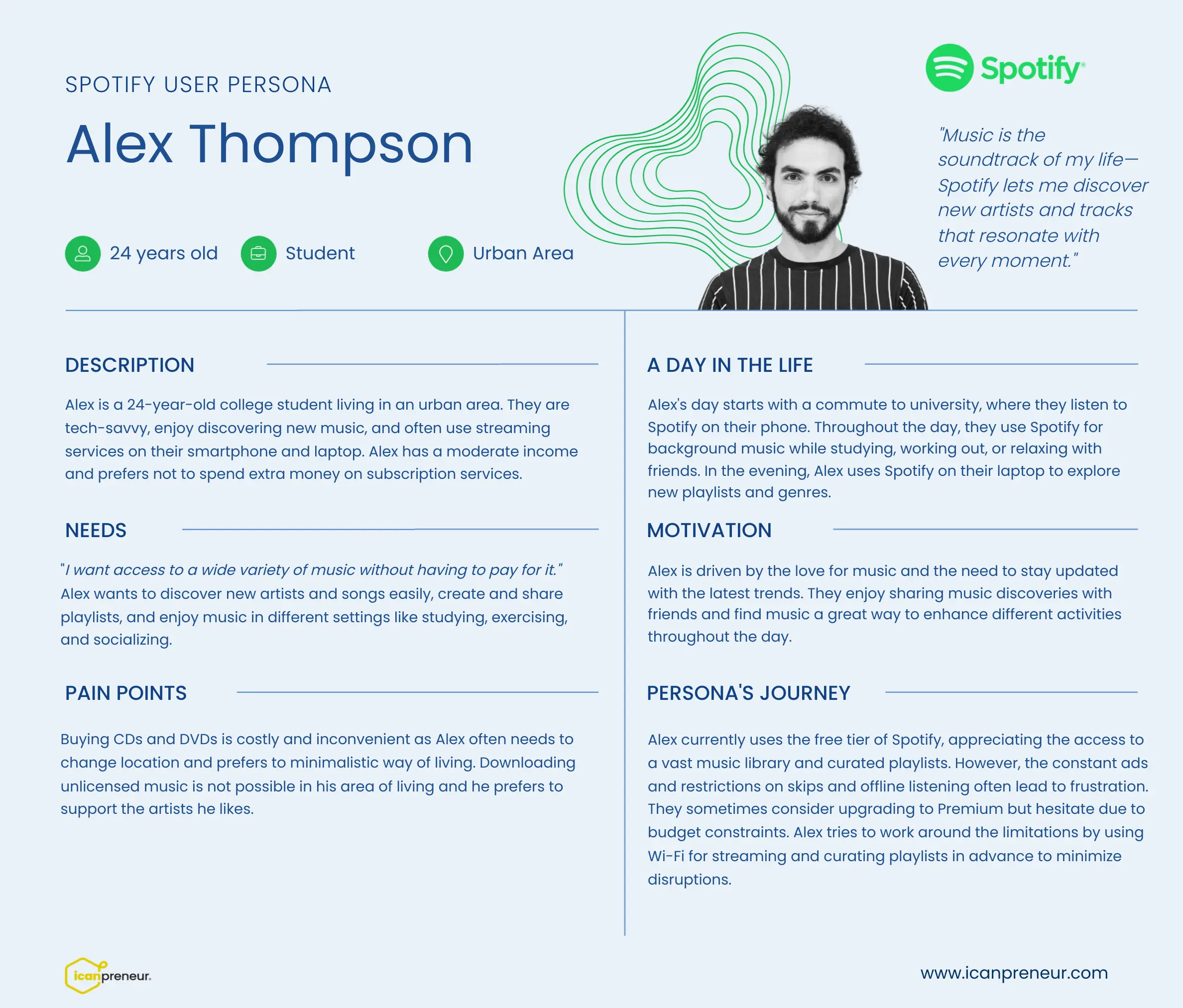
Name:
Alex Thompson
Role/Job Title:
Casual Music Listener
Description:
Alex is a 24-year-old college student living in an urban area. He is tech-savvy, enjoys discovering new music, and often uses streaming services on his smartphone and laptop. Alex has a moderate income and prefers not to spend extra money on subscription services.
A day in the life: Alex's day starts with a commute to university, where he listens to Spotify on their phone. Throughout the day, he uses Spotify for background music while studying, working out, or relaxing with friends. In the evening, Alex uses Spotify on his laptop to explore new playlists and genres.
Needs:
I want access to a wide variety of music without having to pay for it.
Alex wants to discover new artists and songs easily, create and share playlists, and enjoy music in different settings like studying, exercising, and socializing.
Motivation:
Alex is driven by a love for music and the need to stay updated with the latest trends. He enjoys sharing music discoveries with friends and finds music a great way to enhance different activities throughout the day.
Pain Points:
Buying CDs and DVDs is costly and inconvenient as Alex often needs to change location and prefers a minimalistic way of living. Downloading unlicensed music is not possible in his area of living and he prefers to support the artists he likes.
Persona's Journey:
Alex currently uses the free tier of Spotify, appreciating the access to a vast music library and curated playlists. However, the constant ads and restrictions on skips and offline listening often lead to frustration. He sometimes considers upgrading to Premium but hesitates due to budget constraints. Alex tries to work around the limitations by using Wi-Fi to stream and curate playlists in advance to minimize disruptions.
2. Tesla Buyer Persona
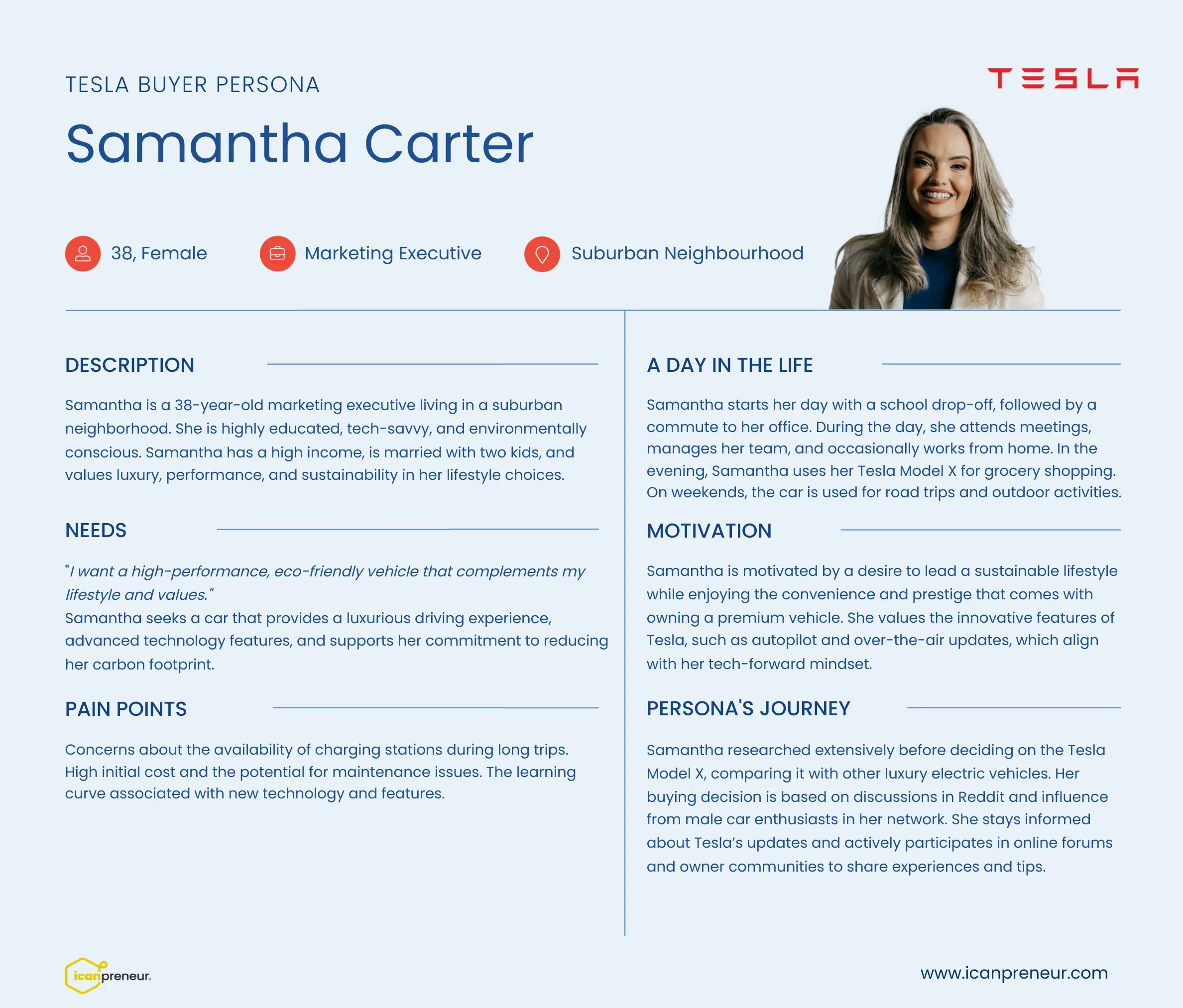
Name:
Samantha Carter
Role/Job Title:
Eco-conscious Senior Executive
Description:
Samantha is a 38-year-old marketing executive living in a suburban neighborhood. She is highly educated, tech-savvy, and environmentally conscious. Samantha has a high income, is married with two kids, and values luxury, performance, and sustainability in her lifestyle choices.
A day in the life:
Samantha starts her day with a school drop-off, followed by a commute to her office. Throughout the day, she attends meetings, manages her team, and occasionally works from home. In the evening, Samantha uses her Tesla Model X for grocery shopping, family outings, and social events. On weekends, the car is used for road trips and outdoor activities.
Needs:
I want a high-performance, eco-friendly vehicle that complements my lifestyle and values.
Samantha seeks a car that provides a luxurious driving experience. She wants advanced technology features which support her commitment to reducing her carbon footprint.
Motivation:
Samantha is motivated by a desire to lead a sustainable lifestyle while enjoying the convenience and prestige that comes with owning a premium vehicle. She values the innovative features of Tesla, such as autopilot and over-the-air updates, which align with her tech-forward mindset.
Pain Points:
Concerns about the availability of charging stations during long trips. High initial cost and the potential for maintenance issues. The learning curve associated with new technology and features.
Persona's Journey:
Samantha researched extensively before deciding on the Tesla Model X, comparing it with other luxury electric vehicles. Her buying decision is based on discussions on Reddit and influence from male car enthusiasts in her network. She stays informed about Tesla’s updates and actively participates in online forums. Samantha is actively participating in owner communities to share experiences and tips.
3. AWS Economical Buyer
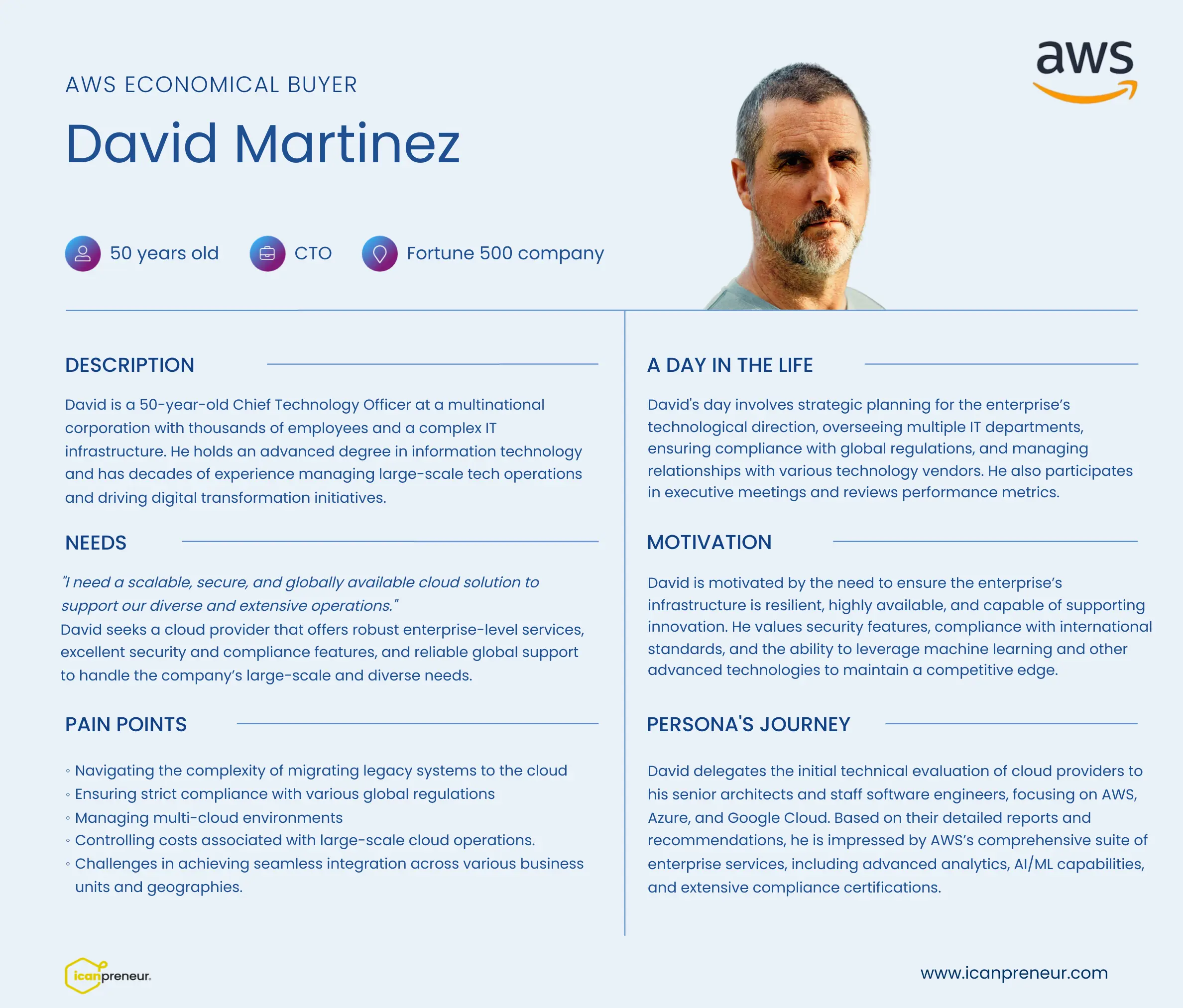
Name:
David Martinez
Role/Job Title:
CTO of a Large Enterprise
Description:
David is a 50-year-old Chief Technology Officer at a multinational corporation with thousands of employees and a complex IT infrastructure. He holds an advanced degree in information technology and has decades of experience managing large-scale tech operations and driving digital transformation initiatives.
A day in the life:
David's day involves strategic planning for the enterprise’s technological direction, overseeing multiple IT departments, and managing relationships with various technology vendors. He participates in executive meetings and makes high-level decisions based on reports and recommendations from his senior technical staff.
Needs:
I need a scalable, secure, and globally available cloud solution that can support our diverse and extensive operations.
David seeks a cloud provider that offers robust enterprise-level services, excellent security and compliance features. He needs a reliable global support to handle the company’s large-scale and diverse needs.
Motivation:
David is motivated by the need to ensure the enterprise’s infrastructure is resilient, highly available, and capable of supporting innovation and digital transformation. He values advanced security features, compliance with international standards, and the ability to leverage data analytics. From his perspective, such advanced technologies are key to maintaining a competitive edge.
Pain Points:
- Navigating the complexity of migrating legacy systems to the cloud
- Ensuring strict compliance with various global regulations
- Managing multi-cloud environments
- Controlling costs associated with large-scale cloud operations.
- Challenges in achieving seamless integration across various business units and geographies.
Persona's Journey:
David delegates the initial technical evaluation of cloud providers to his senior architects and staff software engineers, focusing on AWS, Azure, and Google Cloud. Based on their detailed reports and recommendations, he is impressed by AWS’s comprehensive suite of enterprise services, including advanced analytics, AI/ML capabilities, and extensive compliance certifications.
4. SpaceX Customer Persona
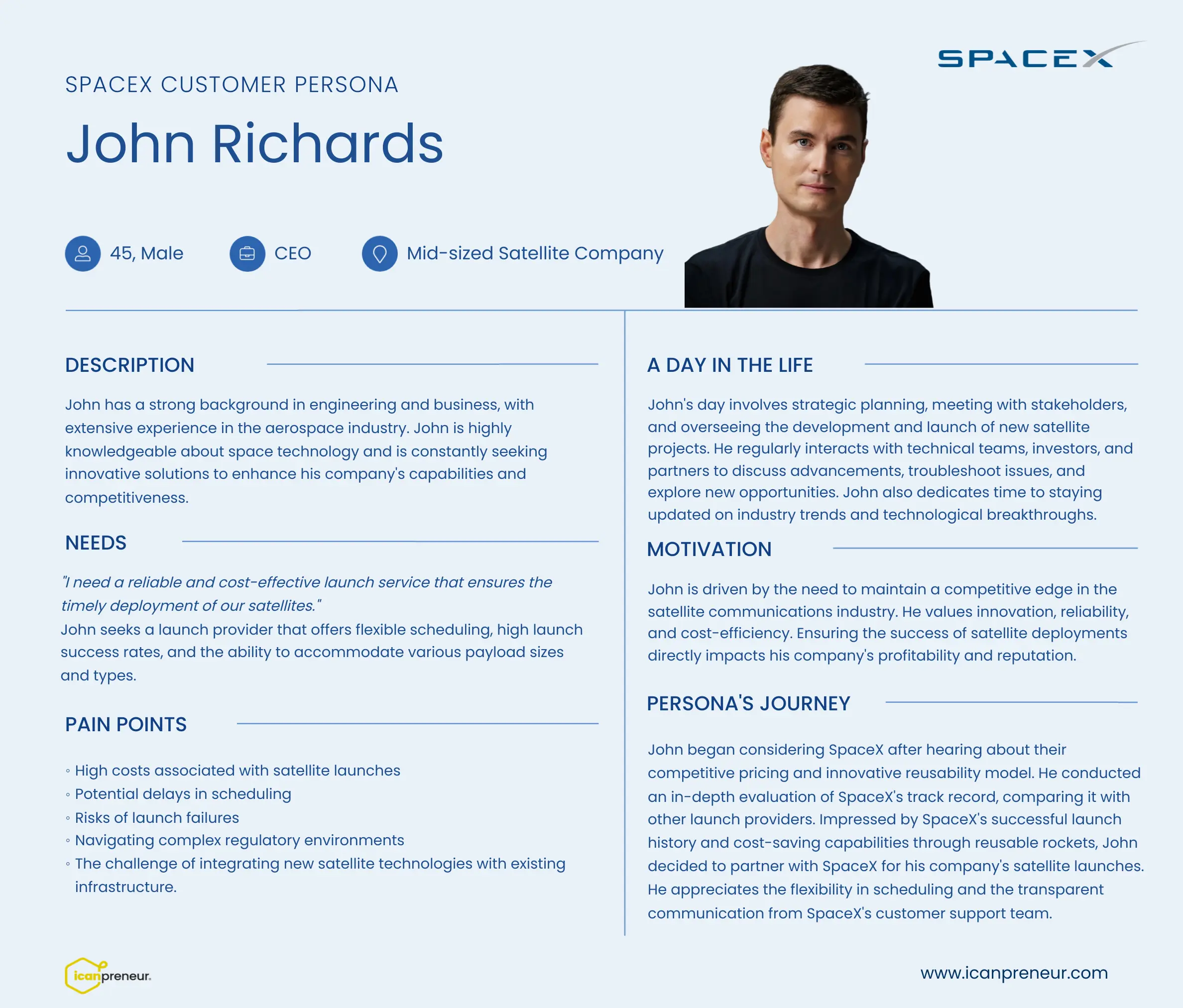
Name:
John Richards
Role/Job Title:
Aerospace Executive
Description:
John is a 45-year-old CEO of a mid-sized satellite communications company. He has a strong background in engineering and business, with extensive experience in the aerospace industry. John is highly knowledgeable about space technology and is constantly seeking innovative solutions to enhance his company's capabilities and competitiveness.
A day in the life:
John's day involves strategic planning, meeting with stakeholders, and overseeing the development and launch of new satellite projects. He regularly interacts with technical teams, investors, and partners to discuss advancements, troubleshoot issues, and explore new opportunities. John also dedicates time to staying updated on industry trends and technological breakthroughs.
Needs:
I need a reliable and cost-effective launch service that ensures the timely deployment of our satellites.
John seeks a launch provider that offers flexible scheduling, high launch success rates, and the ability to accommodate various payload sizes and types.
Motivation:
John is driven by the need to maintain a competitive edge in the satellite communications industry. He values innovation, reliability, and cost-efficiency. Ensuring the success of satellite deployments directly impacts his company's profitability and reputation.
Pain Points:
- High costs associated with satellite launches
- Potential delays in scheduling
- Risks of launch failures
- Navigating complex regulatory environments
- The challenge of integrating new satellite technologies with existing infrastructure.
Persona's Journey:
John began considering SpaceX after hearing about their competitive pricing and innovative reusability model. He conducted an in-depth evaluation of SpaceX's track record, comparing it with other launch providers. Impressed by SpaceX's successful launch history and cost-saving capabilities through reusable rockets, John decided to partner with SpaceX for his company's satellite launches.
He appreciates the flexibility in scheduling and the transparent communication from SpaceX's customer support team. While he remains cautious about potential delays or launch failures, John's confidence is bolstered by SpaceX's proactive approach to risk management and problem-solving.
5. Coursera Master Degree Learner Persona
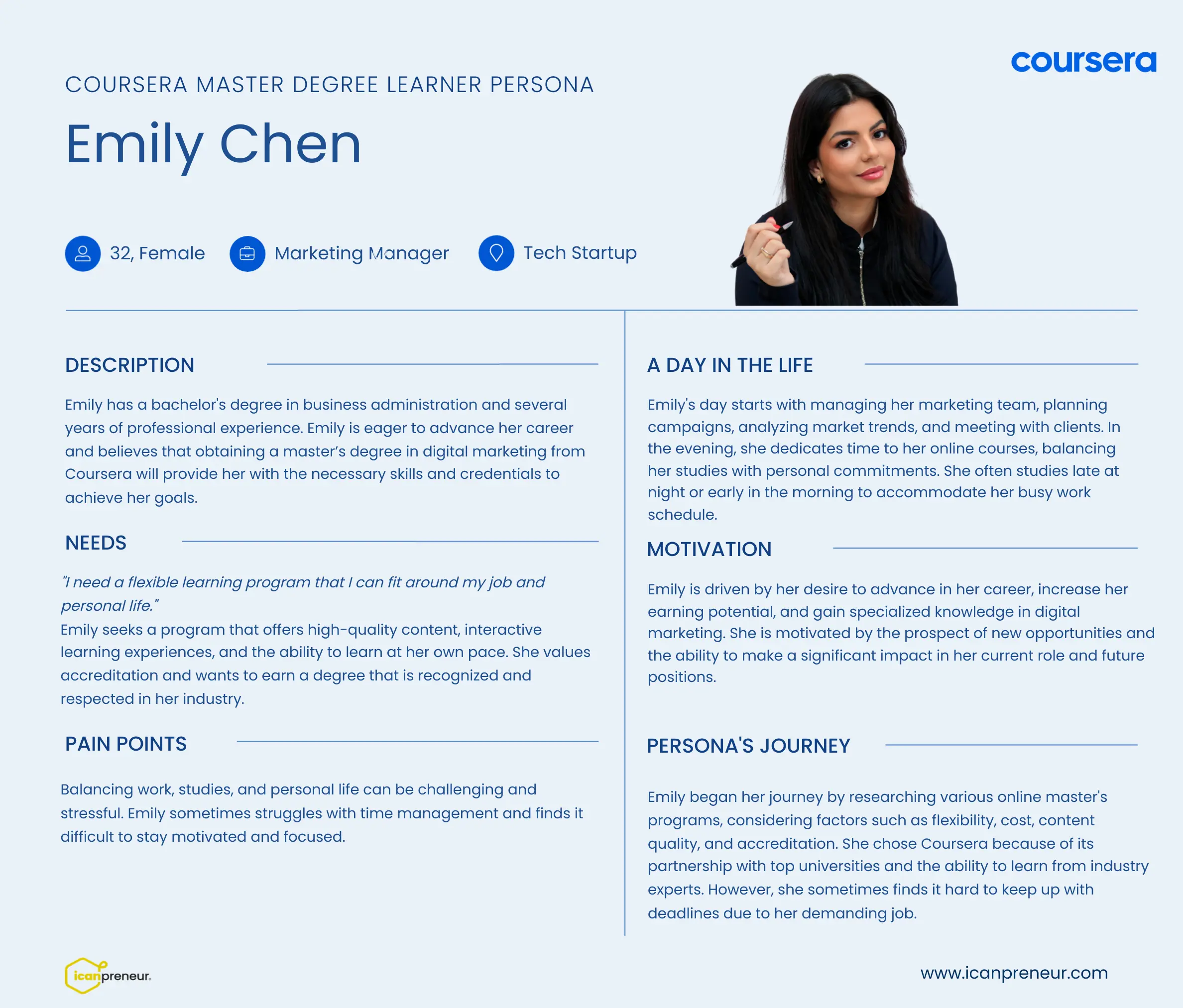
Name:
Emily Chen
Role/Job Title:
Ambitious Professional
Description:
Emily is a 32-year-old marketing manager at a tech startup. She has a bachelor's degree in business administration and several years of professional experience. Emily is eager to advance her career and believes that obtaining a master’s degree in digital marketing from Coursera will provide her with the necessary skills and credentials to achieve her goals.
A day in the life:
Emily's day starts with managing her marketing team, planning campaigns, analyzing market trends, and meeting with clients. In the evening, she dedicates time to her online courses, balancing her studies with personal commitments. She often studies late at night or early in the morning to accommodate her busy work schedule.
Needs:
I need a flexible learning program that I can fit around my job and personal life.
Emily seeks a program that offers high-quality content, interactive learning experiences, and the ability to learn at her own pace. She values formal credentials and wants to earn a recognized and respected degree in her industry.
Motivation:
Emily is driven by her desire to advance in her career, increase her earning potential, and gain specialized knowledge in digital marketing. She is motivated by the prospect of new opportunities and the ability to significantly impact her current role and future positions.
Pain Points:
Balancing work, studies, and personal life can be challenging and stressful. Emily sometimes struggles with time management and finds it difficult to stay motivated and focused.
Persona's Journey:
Emily began her journey by researching various online master's programs, considering factors such as flexibility, cost, content quality, and accreditation. She chose Coursera because of its partnership with top universities and the ability to learn from industry experts. However, she sometimes finds it hard to keep up with deadlines due to her demanding job.
6. Icanpreneur Buyer Persona
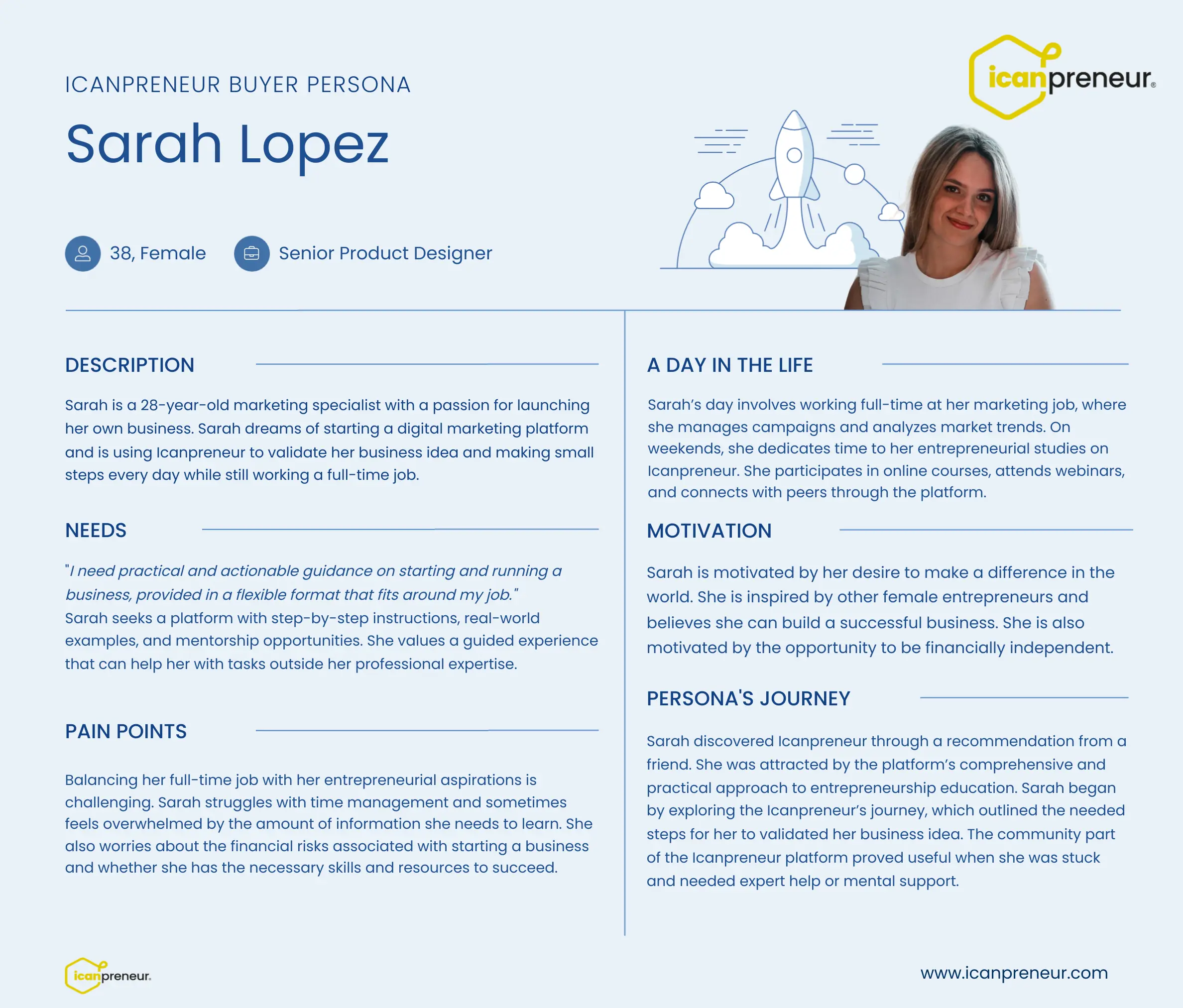
Name:
Sarah Lopez
Role/Job Title:
Aspiring Entrepreneur
Description:
Sarah is a 28-year-old marketing specialist with a passion for launching her own business. Sarah dreams of starting a digital marketing platform and is using Icanpreneur to validate her business idea and making small steps every day while still working a full-time job.
A day in the life:
Sarah’s day involves working full-time at her marketing job, where she manages campaigns and analyzes market trends. On weekends, she dedicates time to her entrepreneurial studies on Icanpreneur. She participates in online courses, attends webinars, and connects with mentors and peers through the platform.
Needs:
I need practical and actionable guidance on starting and running a business, provided in a flexible format that fits in with my job.
Sarah seeks a platform with step-by-step instructions, real-world examples, and mentorship opportunities. She values a guided experience that can help her with tasks outside her professional expertise.
Motivation:
Sarah is motivated by her desire to make a difference in the world. She is inspired by other female entrepreneurs and believes she can build a successful business. She is also motivated by the opportunity to be financially independent.
Pain Points:
Balancing her full-time job with her entrepreneurial aspirations is challenging. Sarah struggles with time management and sometimes feels overwhelmed by the information she needs to learn. The financial risks of starting a business is also among Sarah’s worries and whether she has the necessary skills and resources to succeed.
Persona's Journey:
Sarah discovered Icanpreneur through a friend's recommendation. She was attracted by the platform’s comprehensive and practical approach to entrepreneurship education. Sarah began by exploring the Icanpreneur’s journey, which outlined the steps she needed to validate her business idea. The community part of the Icanpreneur platform proved useful when she was stuck and needed expert help and mental support.
Conclusion
Personas built on authentic customer feedback and client conversations serve as a great way to model your ideal target customer and align your team on the profile of the people you are creating it for. It's often used alongside with other models like the Ideal Customer Profile to provide holistic overview of your target audience. Learn more about the buyer persona from the comprehensive guide with definitions and examples from our blog.
Author
Product @ Icanpreneur. Coursera instructor, Guest Lecturer @ Product School and Telerik Academy. Angel Investor. Product manager with deep experience in building innovative products from zero to millions of users.
